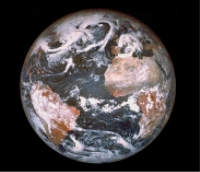
Earth is the third planet from the Sun and is the only planet we know of that has air and water and is able to support life. Earth supports many forms of life - on land, in the water and the air. 70% of Earth's surface is covered by water. Our air and oceans were formed from gases that seeped from the Earth as it cooled after formation.
We are fortunate to have this type of atmosphere - it is quite dense in the lowest region ( up to 10km high) and acts as a filter to shield the surface from harmful rays such as ultra-violet and X-rays. Higher up, it acts as a buffer zone to protect us from bombardment by meteors; most meteors are vaporised by frictional heating, 85 to 100km above the Earth's surface. The air we breathe is a complex mixture of gases of which only two - oxygen and water vapour - are essential for supporting life.
The Earth has a solid core made up mainly of iron and nickel. The outer part of the core is probably a very dense liquid, surrounded by the mantle and then the crust. When the Earth had just been formed, over 4 billion years ago, radioactive material in its interior was generating a great deal of heat. The heat couldn't dissipate quickly enough and the interior grew hotter and hotter.
After another billion years or so, the interior had become so hot that the iron melted and sank to the centre, forming the core. As the Earth cooled. other materials solidified at different distances from the core. Some of these materials now provide a heat source not far below the ground, as evidenced by geothermal and volcanic activity.
The Earth's extensive oceans, ice caps and cloud cover make it very reflective; it reflects approximately half the energy it receives from the Sun.
Physical Data
Diameter: 12 756 km
Surface Temperature: -88 degrees Centigrade to 58 degrees Centigrade
Distance from the Sun: 149.6 million km
Rotation period: 24 hours
Period of orbit: 365 days
Number of moons: one